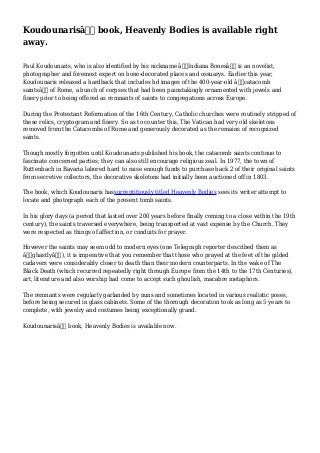
Koudounaris’ book, Heavenly Bodies is available right away.
- 1. Koudounaris’ book, Heavenly Bodies is available right away. Paul Koudounaris, who is also identified by his nickname ‘Indiana Bones’ is an novelist, photographer and foremost expert on bone-decorated places and ossuarys. Earlier this year, Koudounaris released a hardback that includes hd images of the 400-year-old ‘catacomb saints’ of Rome, a bunch of corpses that had been painstakingly ornamented with jewels and finery prior to being offered as remnants of saints to congregations across Europe. During the Protestant Reformation of the 16th Century, Catholic churches were routinely stripped of these relics, cryptogram and finery. So as to counter this, The Vatican had very old skeletons removed from the Catacombs of Rome and generously decorated as the remains of recognized saints. Though mostly forgotten until Koudounaris published his book, the catacomb saints continue to fascinate concerned parties; they can also still encourage religious zeal. In 1977, the town of Ruttenbach in Bavaria labored hard to raise enough funds to purchase back 2 of their original saints from secretive collectors, the decorative skeletons had initially been auctioned off in 1803. The book, which Koudounaris hassurreptitiously titled Heavenly Bodies sees its writer attempt to locate and photograph each of the present tomb saints. In his glory days (a period that lasted over 200 years before finally coming to a close within the 19th century), the saints traversed everywhere, being transported at vast expense by the Church. They were respected as things of affection, or conduits for prayer. However the saints may seem odd to modern eyes (one Telegraph reporter described them as ‘ghastly’), it is imperative that you remember that those who prayed at the feet of the gilded cadavers were considerably closer to death than their modern counterparts. In the wake of The Black Death (which recurred repeatedly right through Europe from the 14th to the 17th Centuries), art, literature and also worship had come to accept such ghoulish, macabre metaphors. The remnants were regularly garlanded by nuns and sometimes located in various realistic poses, before being secured in glass cabinets. Some of the thorough decoration took as long as 5 years to complete, with jewelry and costumes being exceptionally grand. Koudounaris’ book, Heavenly Bodies is available now.